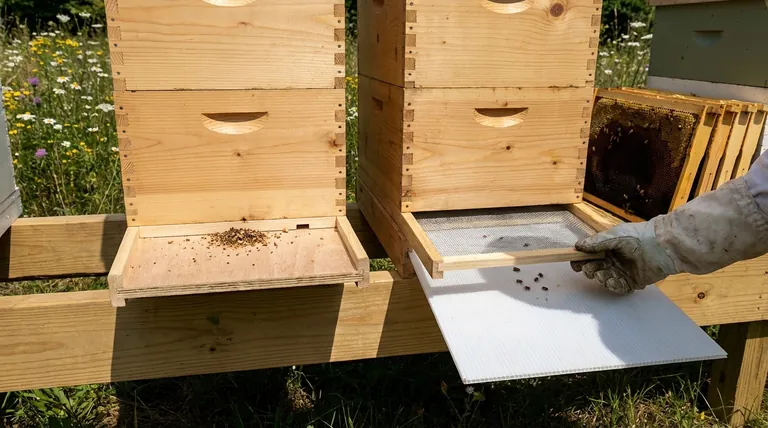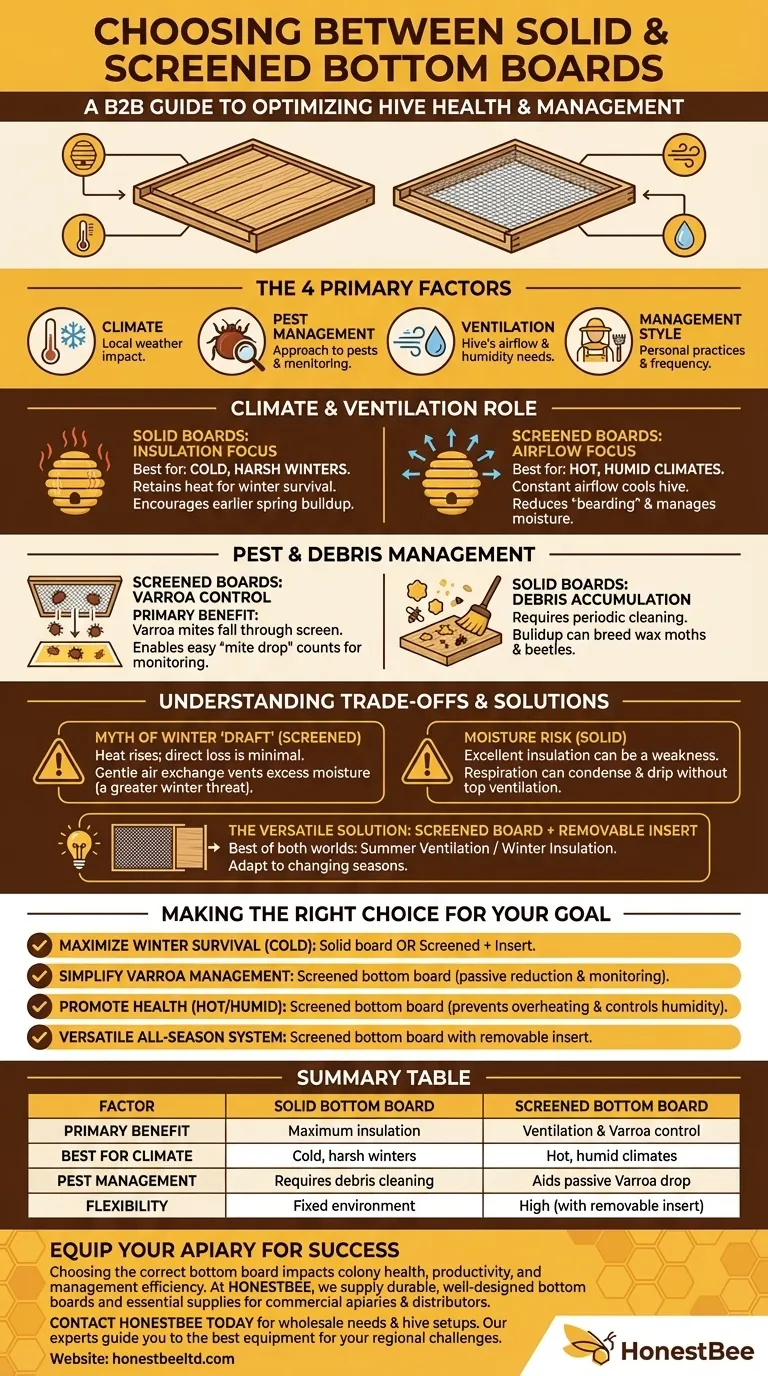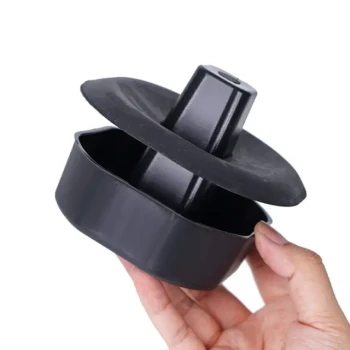The choice between a solid and screened bottom board hinges on four primary factors: your local climate, your approach to pest management, your hive's ventilation needs, and your personal management style. A solid board seals the hive for maximum insulation, while a screened board provides continuous airflow and aids in Varroa mite control.
Your decision is a strategic choice between maximizing hive insulation with a solid board or prioritizing ventilation and pest management with a screened one. Many experienced beekeepers find the most versatile solution is a screened bottom board paired with a removable insert, giving them the flexibility to adapt to changing seasons.

The Role of Climate and Ventilation
The most significant factor in your decision is your environment. The bottom board directly regulates temperature and humidity inside the hive.
Solid Boards for Insulation
In regions with cold, harsh winters, a solid bottom board helps the colony retain heat. This insulation can be crucial for winter survival.
This conserved warmth also encourages the queen to begin laying earlier in the spring, potentially leading to a stronger colony heading into the first nectar flow.
Screened Boards for Airflow
In hot and humid climates, a screened bottom board is invaluable. The constant airflow helps cool the hive, reducing the need for "bearding" (where bees cluster outside the hive entrance to cool off).
This ventilation also plays a critical role in managing moisture, preventing condensation from dripping onto the cluster in winter and reducing the risk of mold and mildew.
Pest and Debris Management
Your philosophy on managing pests, particularly the Varroa destructor mite, will heavily influence your choice.
Screened Boards and Varroa Mites
This is the primary advantage of a screened bottom board. As Varroa mites naturally fall off bees, many will drop through the screen and out of the hive, unable to climb back up.
Furthermore, placing a removable sticky board underneath the screen allows for easy and accurate "mite drop" counts, giving you crucial data on infestation levels without disturbing the colony.
Solid Boards and Debris
A solid board allows debris like wax cappings, pollen, and dead bees to accumulate on the hive floor.
This buildup must be cleaned periodically, as it can become a breeding ground for pests like wax moths and small hive beetles.
Understanding the Trade-offs
Neither option is perfect. Understanding their respective drawbacks is key to making an informed decision and mitigating risks.
The Myth of the Winter "Draft"
A common concern is that a screened bottom board creates a harmful draft in winter. However, since heat rises, the direct heat loss is minimal.
The gentle air exchange actually helps vent excess moisture, which is often a greater threat to a wintering colony than the cold itself. A wet colony is a cold colony.
Solid Boards and Moisture Risk
The excellent insulation of a solid board can also be its weakness. Without proper ventilation at the top of the hive, moisture from the bees' respiration can condense on the cold inner cover.
This condensation can drip down onto the cluster, chilling the bees and creating an environment ripe for disease.
Versatility as a Solution
Many beekeepers use a screened bottom board with a removable insert (often a corrugated plastic or wood slider). This provides the best of both worlds: remove the insert for summer ventilation and mite counts, and slide it in for winter insulation.
Making the Right Choice for Your Goal
Select your equipment based on your primary objective for hive health and management.
- If your primary focus is maximizing winter survival in a cold climate: A solid board or a screened board with the insert left in provides the best insulation.
- If your primary focus is simplifying Varroa mite management: A screened bottom board is the superior tool for passive mite reduction and monitoring.
- If your primary focus is promoting hive health in a hot, humid climate: A screened bottom board provides essential ventilation to prevent overheating and control humidity.
- If your primary focus is having a versatile, all-season system: A screened bottom board with a removable insert offers the most flexibility to adapt to any condition.
Ultimately, the right bottom board is the one that best equips you to manage your local challenges and support a thriving colony.
Summary Table:
| Factor | Solid Bottom Board | Screened Bottom Board |
|---|---|---|
| Primary Benefit | Maximum insulation for winter | Ventilation & Varroa mite control |
| Best For Climate | Cold, harsh winters | Hot, humid climates |
| Pest Management | Requires periodic debris cleaning | Aids in passive Varroa mite drop |
| Flexibility | Fixed environment | High (especially with removable insert) |
Equip your apiary with the right foundation for success.
Choosing the correct bottom board is a critical decision that impacts colony health, productivity, and your management efficiency. At HONESTBEE, we supply commercial apiaries and equipment distributors with durable, well-designed bottom boards and other essential beekeeping supplies through our wholesale-focused operations.
Let us help you build a stronger, healthier operation. Our experts can guide you to the best equipment for your specific regional challenges and management goals.
Contact HONESTBEE today to discuss your wholesale needs and optimize your hive setups.
Visual Guide

Related Products
- Langstroth Solid Bottom Board for Beekeeping
- Langstroth Screen Bottom Board for Beekeeping Wholesale
- Australian Pine Wood Langstroth Screen Bottom Board for Wholesale
- HONESTBEE Professional Frame Wiring Board and Jig
- HONESTBEE Durable Frame Wiring Board with Integrated Tensioner
People Also Ask
- How is the solid bottom board constructed to ensure durability? Built for Longevity with Quality Wood & Beeswax
- What is the recommended approach for choosing between different types of hive boards if you have multiple hives?
- What is the suggested approach for choosing hive boards if you have only 1 or 2 hives? Test Both Types to Find Your Perfect Fit.
- What is the purpose of a solid bottom board in a hive? Essential for Winter Survival & Insulation
- How do honeybees adapt to different bottom board types in terms of temperature regulation? Optimize Your Hive Climate



















